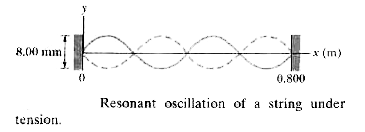Figure 16-37 shows resonane oscillation of a string of mass m=2.500 g and lengt L= 0.800 m and that is under tension τ=325.0N. What is the wavelength λ of the transverse waves producing the standing wave patient and what is the charmant number. What is the frequency of the transverst waves and of the osciallation of the moving string elements? What is the maximum magnitude of the transverse velocity um of the element oscillating a coordinate x =0.180 m? At what point during the element's oscillation is the transverse velocity maximum?
Text Solution
(a) The transverse waves that produce standing wave pattern must have a wavelength such that inter number n of half-wavelengths fit into the length L of the string.

(2) The frequency of those waves and of the oscillations of the string elements is given by Eg. 16-75 (f=nv/2L).
(3) The displacement of a string element as a function of position X and timer is given by Eq, 16-66:
y.(x,t)=[2ymsinkx]cosωt
Wavelength and harmonic number: In Fig. 16-37, the solid line, which is effectively a snapshot (or freeze-frame) of the oscillations, reveals that 2 full wavelengths fit into the length L=0.800 m of the string. Thus, we have
2λ=L,
or λ=L2
=0.800m2=0.400m
By counting the number of loops (or half-wavelengths) in Fig. 16-37, we see that the harmonic number is
n=4
We also find n=4 by comparing Eqs. 16-78 and 16-74 (λ=2L/n). Thus, the string is oscillating in its fourth harmonic.
Frequency. We can get the frequency of the transverse waves from Eq. 16.15 (v=λf) if we first find the speed v of the waves. That speed is given by Eq 16:29, but we must substitute m/L, for the unknown lincar kiensity μ. We obtain
v=√τμ=√τm/L=√τLm
=√(325N)(0.080m)2.50×10−3kg=322.49m/s
After rearranging Eq. 16-15, we write
f=vλ=322.49m/s0.400m
=806.2Hz= 806 Hz
|
Topper's Solved these Questions
- WAVES-IBOOK - RESNICK AND HALLIDAYCHAPTER - WAVES-IEXERCISE - Checkpoint
8 Videos
- WAVES-IBOOK - RESNICK AND HALLIDAYCHAPTER - WAVES-IEXERCISE - Problems
60 Videos
- WAVE - IIBOOK - RESNICK AND HALLIDAYCHAPTER - WAVE - IIEXERCISE - PRACTICE QUESTIONS (INTEGER TYPE)
5 Videos
- WORK, POWER, AND ENERGYBOOK - RESNICK AND HALLIDAYCHAPTER - WORK, POWER, AND ENERGYEXERCISE - PRACTICE QUESTIONS (Integer Type)
5 Videos
Similar Questions
Knowledge Check
If the speed of a transverse wave on a stretched string of length 1 m is 60ms−1, what is the fundamental frequency of vibration ?
A40 HzB45 HzC35 HzD30 HzThe maximum or thershold wavelength of transverse stationary wave on a string of length l is
AlB2lCl2D4lIn a string under tension T, the velocity of transverse wave travelling along it is
A∝TB∝√TC∝T2D∝T−1
A steel wire 70cm long has a mass of 7.0g. If the wire is under a tension of 100N, what is the speed of transverse waves in the wire?
View SolutionA transverse wave is produced on a stretched string 0.9 m long and fixed at its ends. Find the speed of the transverse wave, when the string vibrates while emitting second overtone of frequency 324 Hz.
View SolutionWhat is the speed of a transverse wave in a rope of length 10 m and mass 80 gm under a tension of 80 N?
View SolutionWhat is the speed of a transverse wave in a rope of length 10 m and mass 80 gm under a tension of 80 N?
View SolutionWhat is the speed of a transverse wave in a rope of length 10 m and mass 80 gm under a tension of 80 N?
View Solution
